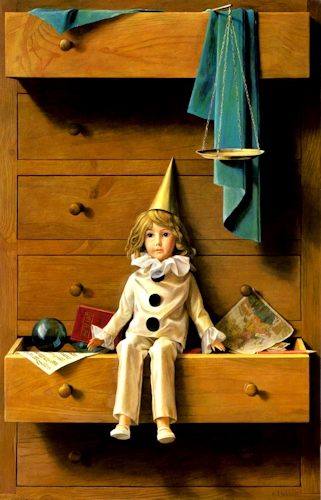《Chest of drawers (tromp l'oeil)》 1977
《Chest of drawers (tromp l'oeil)》 1977 100.0x65.0cm Oil/Canvas
This work is one of Iwata's representative trompe l'oeil works, and an
illustration was introduced in “MIZUE Summer 1982 No.923”. It was also
exhibited at a comparison exhibition at the Grand Palais in Paris in 1976,
and after making some additions, it was exhibited at the second solo exhibition
at the Art Gallery Central in Tokyo in 1977, and was purchased and stored
at the National Museum of Art, Osaka.
Motifs such as drawers, balance scales, and musical scores were already
depicted in 《Doll and drawer (trompe l'oeil)》 (1971), which was created
six years earlier, but the dolls were drawn by a girl with a three-cornered
hat. She has been replaced by a child, Harlequin (who plays the role of
the lover in the clown play), dressed in white. This work includes a study
in gouache (opaque watercolor), 《Chest of drawers》 (1975), and Iwata continued
to work on Harlequin's 《Arlequin (trompe l'oeil)》 (1980), painted on a
chest with a single door. he pursued a child's Harlequin doll that overlapped
with his own childhood memories.
This work is also an ambitious work that attempts to express a “Convex
space”' in the expression of trompe l'oeil. "Convex space" is
nothing but a part of the real space where the viewer is. Trompe l'oeil
requires an expression that appears to be “connected” to real space, but
the expression of “Convex space” must go even further to the point where
it “blends” into real space. Looking at past examples of trompe l'oeil,
apart from small items such as pieces of paper such as “letter rack”, which
are typical examples of “Convex spaces”, there are also cases of slightly
larger objects such as duck hunting prey hung on the wall. You can see
that the latter is quite difficult. It seems that Iwata was well aware
of the difficulty, and apart from this work, there are no other works that
deal with large “Convex spaces”, other than studies.
The spherical glass ball in the picture is, as a symbol, it shows Iwata's various swaying states of mind, and here it also serves as a spherical mirror that reflects the entire interior of the room. As a painter who expresses the mysteries of the art of painting, it also serves as a showcase for his trompe l'oeil skills. Although the anthropomorphic doll, Iwata himself, is at the mercy of fate, we can feel his positive will to live freely as an artist.
